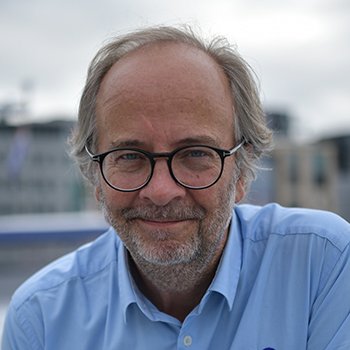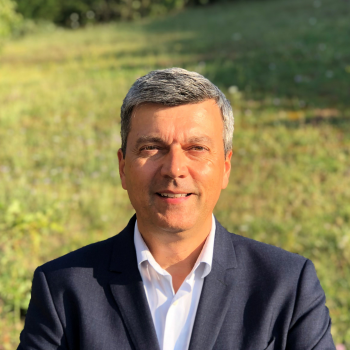The Energy Observer is an environmental advocate as well as a promoter of change and green transition. With the help of its industrial subsidiary, Energy Observer Developments (EODev), it proposes solutions that optimize the future for energy. Naturally, Rockwell Automation, one of its long-standing partners, provides it with support for these changes. Hastening the green transition has always been the leitmotif of the Energy Observer’s teams. Managing Director Louis-Noël Viviès discussed it with us.
1. Could you briefly present the Energy Observer project and its mission?
Louis-Noël Viviès: The Energy Observer ship has been sailing around the world since 2017, stopping off in many iconic cities to meet the people who are working hard to come up with sustainable solutions for a more harmonious world. The Energy Observer is the leading French ambassador of the UN’s 17 Sustainable Development Goals and its mission is to raise awareness of the challenges inherent in the green transition.
The boat is also a lab where engineers, researchers, and scientists from different backgrounds have developed a smart energy mix system. This system combines solar, wind, and tidal power within the complete green hydrogen production chain1 on board. It enables compensation for the intermittent nature of renewables and serves as long-term storage alongside batteries. All of our technology has been tried and tested and optimized over 5 years and 40,000+ nautical miles in the most demanding environment in the world, the ocean. Ultimately, the multi-energy system we developed with our industrial partners has proven its effectiveness and resiliency.
Developing reliable, sustainable energy solutions without harmful emissions, and that are economically accessible, is what we’re up against in our quest.
2. France has put forward two Hydrogen proposals, the first in through the Ministry of Ecological Transition and a second, €7B one in September 2020. Did you expect the industry would receive this much support from the government when you first began?
Louis-Noël Viviès: We’re proud of our progress since 2017. We believe that our ship’s technology and the awareness we’ve raised with the public, elected officials, decision makers, the media, and manufacturers have contributed to hastening the green transition and enhancing the European Hydrogen Plan announced in the fall.
Last May 25th, for the first time ever, the Eiffel Tower was lit up using Air Liquide’s certified renewable hydrogen and GEH2® , the electro-hydrogen generator developed by EODev.
Our “Paris de l’hydrogène” event was a highlight under the France Relance recovery plan, which showcases the hydrogen sector, both on symbolic and historic levels. It was also a concrete message that we broadcast far and wide, “Green hydrogen technology is reliable and can be used to support the power grid.”
The “Hydrogen” Plan investments are necessary for the transition on an industrial scale, both for energy storage and mobility.
3. What is the development strategy behind the creation of the EODev subsidiary?
Louis-Noël Viviès: As we traveled through Europe, we realized that there were very few concrete hydrogen-based projects, particularly in the maritime sector. Spurred on by our partners, we decided to create our own company to accelerate the development of green hydrogen-powered solutions.
We named the company EODev and raised funds for it in 2020 from contributors such as Accor, Thelem Assurance, and Amfil. The Monnoyeur Group, the leading player in decentralized energy, and Toyota later joined them.
In 2019, the EODev and Toyota teams developed REXH2®, a solution that prolongs sea vessel autonomy. We then created GEH2® based on this solution, which had already been tested on the Energy Observer. It is the first 100 KVA hydrogen power generator and was used to light up the Eiffel Tower, and more recently, for boating events in the south of France.
We are laser focused on ensuring that the innovations developed on the Energy Observer can be shared and deployed for as many users as possible. So EODev is here to share the Energy Observer’s breakthroughs, with products that are both technically and financially accessible.
4. What roles do your partnerships play in terms of meeting your goals?
Louis-Noël Viviès: We rely on the commitment of 60 companies and public and private institutions to help us accelerate the energy and green transition. They make the Energy Observer's voyages and EODev’s developments possible with their stalwart financial, technical, and human support.
Each one contributes something specific, something that is often indispensable. The Energy Observer project’s independence allows it to collaborate with the best specialists within each technological element, to develop complete systems more quickly, e.g., fuel cells, controllers, solar panels, propulsion wings, hydrogen tanks, batteries, and more. All our partners are motivated by the same objective: to shake things up in a tangible and efficient way.
5. Why did you choose Rockwell Automation to be your industrial partner?
Louis-Noël Viviès: There were two essential reasons that led us to choose Rockwell Automation. The first relates to our partnership, which began at the same time as the project, in 2016/2017. The group provided us with their expertise, software, and controls back when hydrogen hadn’t yet begun trending. The second is tied to Rockwell Automation’s skills, as the company is second to none in the field of automation. Their comprehensive and innovative solutions enable the creation of systems with components from various suppliers.
6. What are the priority work areas of this collaboration?
Louis-Noël Viviès: All of our on-board system architecture is powered by Rockwell solutions. An Energy Management System coded via Rockwell software manages the solar power, wind power, hydrogen storage, and batteries, even the propulsion wings.
The Energy Observer has also had a TEchConnect support contract for years and uses Studio 5000 to manage its controls and FT ViewPoint and View Studio for the human-machine interface and communications.
7. What benefits are you expecting from your partnership with Rockwell?
Louis-Noël Viviès: The “industrial” products and solutions developed by EODev with the same tools as those used on board the Energy Observer must achieve a high level of quality. To reach that point, Rockwell provides us with their experience, international network, and technology that are strategic assets for our solutions, which we aim to be reliable, robust, universal, and accessible.
8. What can you tell us about your upcoming projects?
Louis-Noël Viviès: We’re going to develop next-gen energy systems for shipping, industrial maritime transport with real technological breakthroughs. To shake things up quickly and tangibly, we have to create more powerful propulsion systems and work on new ways to store energy that are more compact and just as light. Rockwell will continue to be an ever essential partner.
1 - Green hydrogen, produced by water electrolysis using renewable power (wind, solar) is stored as a gas in a tank. A fuel cell converts this gas into electric energy when there is no sun or wind. Another advantage is that the only byproduct of this process is water. We call it “green” hydrogen, as opposed to “gray” hydrogen, which is produced using hydrocarbons and is thus not as virtuous in terms of CO2emissions.
Image: © Energy Observer Productions I Bahamas
Published July 4, 2022



